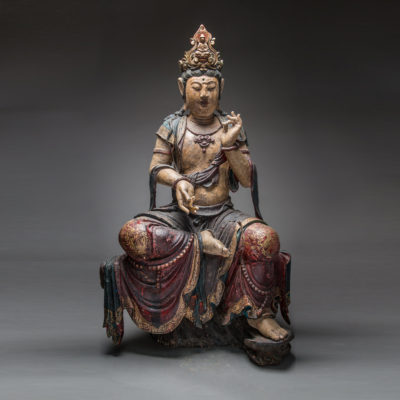
| SKU | AM.0160 |
|---|---|
| Circa | 1368 AD to 1644 AD |
| Dimensions | 39.5″ (100.3cm) high x 24″ (61.0cm) wide |
| Medium | Wood |
| Origin | China |
| Gallery Location | UK |
Buddhism was introduced to China from India in the early years of the first millennium. This statue represents the bodhisattva of mercy, known as Avalokiteshvara (or Guanyin in Chinese). Bodhisattvas were originally depicted as the Buddha’s attendants but increasingly came to be venerated in their own right. Usually dressed in elaborate attire, bodhisattvas were enlightened beings who had chosen to delay their entry into Nirvana to help other sentient beings end the cycle of birth and rebirth. Avalokiteshvara is identifiable by the small seated Buddha that appears in the headdress. This figure was immensely popular in China and it has been estimated that by the Tang period the number of images outnumbered those of the historical Buddha Shakyamuni. Although Buddhist texts do not specify the gender of bodhisattvas, the early examples tend to be male. From the end of the Song dynasty (1279) this trend was reversed and by the Ming period such images are clearly feminine.
In this sculpture Avalokiteshvara is seated on a carved base resembling the trunk of a tree. The figure’s left leg is positioned downwards, resting on a protruding plinth. The right leg is bent inwards on the stand with the sole of the foot revealed. The positioning of the arms, one raised and one lowered, lends the figure a pleasing visual balance. The wrists are adorned with red bracelets and in both hands the thumb rests lightly against the middle finger. Other traditional attributes also appear, such as the elongated ears and the dot (urna) on the forehead symbolising understanding. The facial expression is especially serene with its large closed eyelids. The overall effect is one of immense calm and meditation.
The appeal of this object is enhanced by the considerable remains of the original polychromy. In particular, red and green pigments adorn the headdress and the delicately carved drapery. This has been expertly chiselled to fall over the front of the base and is highlighted with gilding. The use of gold is most elaborate on the fabric covering the knees where it outlines two twisting dragons set among the clouds. Also remarkable is the care lavished on the beads below this. They are carved almost entirely in the round.
This piece is an expression of religiosity but also a demonstration of exquisite skill. The celestial scarf, for example, which falls towards the waist length tunic gives the impression of real fabric. There is also an attention to detail on the reverse of the figure. Although it is not known where this sculpture would have been displayed, the care taken over the folds of the shoulder mantle on the reverse suggest that it would have been visible from both sides.
Login to view price
Sign-up to receive the latest Wedding Estates news and promotions!

